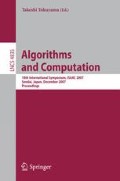Abstract
Gossiping is an important problem in Radio Networks that has been well studied, leading to many important results. Due to strong resouce limitations of sensor nodes, previous solutions are frequently not feasible in Sensor Networks. In this paper, we study the gossiping problem in the restrictive context of Sensor Networks. By exploiting the geometry of sensor node distributions, we present reduced, optimal running time of O(D + Δ) for an algorithm that completes gossiping with high probability in a Sensor Network of unknown topology and adversarial wake-up, where D is the diameter and Δ the maximum degree of the network. Given that an algorithm for gossiping also solves the broadcast problem, our result proves that the classic lower bound of [16] can be broken if nodes are allowed to do preprocessing.
This research was supported in part by NSF grants CCF0621425, CCF 05414009, CCF 0632838, and DIMACS, Center for Discrete Mathematics & Theoretical Computer Science, grant numbered NSF CCR 00-87022.
Access this chapter
Tax calculation will be finalised at checkout
Purchases are for personal use only
Preview
Unable to display preview. Download preview PDF.
References
Bar-Yehuda, R., Goldreich, O., Itai, A.: On the time-complexity of broadcast in multi-hop radio networks: An exponential gap between determinism and randomization. Journal of Computer and System Sciences 45, 104–126 (1992)
Bar-Yehuda, R., Israeli, A., Itai, A.: Multiple communication in multihop radio networks. SIAM Journal on Computing 22, 875–887 (1993)
Bruschi, D., Pinto, M.D.: Lower bounds for the broadcast problem in mobile radio networks. Distributed Computing 10(3), 129–135 (1997)
Chlamtac, I., Weinstein, O.: The wave expansion approach to broadcasting in multihop networks. In: Proc. of INFOCOM (1987)
Chlebus, B., Ga̧sieniec, L., Lingas, A., Pagourtzis, A.: Oblivious gossiping in ad-hoc radio networks. In: Proc. of 5th International Workshop on Discrete Algorithms and Methods for Mobile Computing and Communications, pp. 44–51 (2001)
Chrobak, M., Ga̧sieniec, L., Rytter, W.: Fast broadcasting and gossiping in radio networks. In: Proc. of the 41st IEEE Annual Symp. on Foundation of Computer Science (2000)
Chrobak, M., Ga̧sieniec, L., Rytter, W.: A randomized algorithm for gossiping in radio networks. Networks 43(2), 119–124 (2004)
Clementi, A., Monti, A., Silvestri, R.: Selective families, superimposed codes, and broadcasting on unknown radio networks. In: Proc. of the 12th Annual ACM-SIAM Symposium on Discrete Algorithms (2001)
Czumaj, A., Rytter, W.: Broadcasting algorithms in radio networks with unknown topology. In: Proc. of the 44th IEEE Annual Symp. on Foundation of Computer Science (2003)
Farach-Colton, M., Fernandes, R.J., Mosteiro, M.A.: Bootstrapping a hop-optimal network in the weak sensor model. In: Brodal, G.S., Leonardi, S. (eds.) ESA 2005. LNCS, vol. 3669, pp. 827–838. Springer, Heidelberg (2005)
Fejes-Tóth, L.: über einen geometrischen satz. Mathematische Zeitschrift 46(1), 83–85 (1940)
Ga̧sieniec, L., Potapov, I.: Gossiping with unit messages in known radio networks. In: Proc. of 17th IFIP World Computer Congress / 2nd IFIP International Conference on Theoretical Computer Science (2002)
Geréb-Graus, M., Tsantiles, T.: Efficient optical communication in parallel computers. In: 4th Annual ACM Symposium on Parallel Algorithms and Architectures pp. 41–48 (1992)
Kowalski, D.R.: On selection problem in radio networks. In: Proceedings 24th Annual ACM Symposium on Principles of Distributed Computing, pp. 158–166 (2005)
Kowalski, D.R., Pelc, A.: Time of deterministic broadcasting in radio networks with local knowledge. SIAM Journal on Computing 33(4), 870–891 (2004)
Kushilevitz, E., Mansour, Y.: An Ω(Dlog(N/D)) lower bound for broadcast in radio networks. SIAM Journal on Computing 27(3), 702–712 (1998)
Liu, D., Prabhakaran, M.: On randomized broadcasting and gossiping in radio networks. In: Ibarra, O.H., Zhang, L. (eds.) COCOON 2002. LNCS, vol. 2387, pp. 340–349. Springer, Heidelberg (2002)
Mitzenmacher, M., Upfal, E.: Probability and Computing: Randomized Algorithms and Probabilistic Analysis. Cambridge University Press, Cambridge (2005)
Moscibroda, T., Wattenhofer, R.: Maximal independent sets in radio networks. Technical Report TR-478, Computer Engineering and Networks Laboratory, ETH Zurich, 8092 Zurich, Switzerland (December 2004)
Ravelomanana, V.: Optimal initialization and gossiping algorithms for random radio networks. IEEE Trans. Parallel Distr. Syst. 18(1), 17–28 (2007)
Author information
Authors and Affiliations
Editor information
Rights and permissions
Copyright information
© 2007 Springer-Verlag Berlin Heidelberg
About this paper
Cite this paper
Farach-Colton, M., Mosteiro, M.A. (2007). Sensor Network Gossiping or How to Break the Broadcast Lower Bound . In: Tokuyama, T. (eds) Algorithms and Computation. ISAAC 2007. Lecture Notes in Computer Science, vol 4835. Springer, Berlin, Heidelberg. https://doi.org/10.1007/978-3-540-77120-3_22
Download citation
DOI: https://doi.org/10.1007/978-3-540-77120-3_22
Publisher Name: Springer, Berlin, Heidelberg
Print ISBN: 978-3-540-77118-0
Online ISBN: 978-3-540-77120-3
eBook Packages: Computer ScienceComputer Science (R0)

